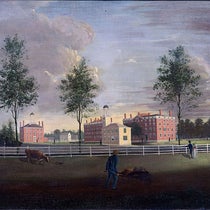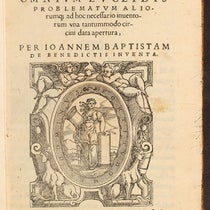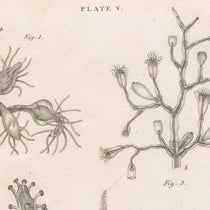Scientist of the Day - Josiah D. Whitney
Josiah Dwight Whitney, an American geologist, died Aug. 18, 1896 (although it might have been Aug. 15, or 19), at the age of 76. Whitney became professor at Harvard in 1865, but he spent much of his time and energy in California, where he was appointed State Geologist and Director of the California Geological Survey in 1860. He held that position until 1874.
In the eyes of the California legislature, his job was to find gold, but Whitney followed the lead of New York State and intended his survey to include volumes on paleontology and natural history, as well as geology. The state and Whitney did not see eye- to-eye on this, and in 1867, the state withdrew all financial support, although Whitney kept his title and now-unpaid position. But publications of the survey were piecemeal.
One byproduct of the survey, however, was magnificent: a large book called The Yosemite-Book. Whitney and his team (which included Clarence King, who would go on to head up an important geological survey of his own) were very impressed by the scenic grandeur of Yosemite Valley, and Whitney thought it should be preserved as a state or national park (bear in mind that there were no state or national parks at the time), and he thought a book that presented visually the beauty of Yosemite might create public interest in preserving Yosemite as an unspoiled wilderness. There happened to be a professional photographer, Carleton E. Watkins, at Yosemite when the survey team was there, and Whitney commissioned photographs from Watkins, which were recorded on massive 22-inch glass plates. Whitney included 24 of these in The Yosemite-Book, and we show four of them here, including El Capitan, Cathedral Rock, and Yosemite and Bridal Veil Falls.
The plates in the book have large white borders, which effectively mattes the photos in the book, but when you reproduce them that way, much of the detail is lost. So I have cropped the plates to the borders of the photographs here, with one exception, so you can see what they look like in the book.
Whitney also included two large folding maps, of Yosemite Valley, and the nearby Sierra Nevada range. We show the first map here (sixth image), as well as a detail of just the valley, where you may be able to read the labels identifying features such as El Capitan and Yosemite Falls (seventh image). They are said to be inaccurate, but they are lovely to look at.
Whitney had intended his book as a travel guide to a future park, but to accommodate the photographs, he had to make it quarto-sized. The 28 photographs (four more by a different photographer were added) are actual albumen prints that were pasted into the book – there was no other way at the time to reproduce photographs, except for the expensive Woodburytype process. The Yosemite-Book would not be finding its way into anyone's pocket. And Whitney could only afford to publish 250 copies, intended for legislators and cabinet members. So Whitney immediately issued The Yosemite Guide-Book, which was quite a different kettle of fish, having the same text but only wood engravings – no photographs. And he published an even smaller-sized edition, with no images at all except a map, which would really fit in your pocket. We have 4 editions of the Guide-book, published between 1870-74. The large-octavo edition of 1870 is impressive in its own right – the wood engravings are beautiful – and might be worth its own post, but today we stick with the quarto.
Whitney deserves national appreciation for helping save Yosemite for future generations, but otherwise, he was pretty much of a professional washout. The problems with the California legislature were mostly his intemperate fault, which he could have cleared away with a little tact. He became involved in a number of professional controversies, in which, in every case, he was on the wrong side. For example, John Muir thought that much of Yosemite had been shaped by glacial action. Whitney ridiculed the idea, and ridiculed Muir, and denied that glaciers had played any kind of a geological role anywhere in California. He really seems to have been an unpleasant, obstinate, and unreasonable man. It is unfortunate that the highest mountain in the contiguous United States was named in his honor (by the members of his survey team in 1864). It would have been much better, and more appropriate, if some feature in Yosemite had been named, say, the Whitney Dome. Or better yet, Whitney Falls.
William B. Ashworth, Jr., Consultant for the History of Science, Linda Hall Library and Associate Professor emeritus, Department of History, University of Missouri-Kansas City. Comments or corrections are welcome; please direct to ashworthw@umkc.edu.

![Bridal Veil Falls, photograph by Carleton E. Watkins, albumen print, cropped, in The Yosemite-Book, by Josiah D. Whitney, 1868 [1869] (Linda Hall Library)](https://assets-us-01.kc-usercontent.com:443/9dd25524-761a-000d-d79f-86a5086d4774/7c13b1d5-79b9-497e-bb17-c9b97735b81c/whitney1.jpg?w=449&h=489&auto=format&q=75&fit=crop)
![Bridal Veil Falls, photograph by Carleton E. Watkins, albumen print, cropped, in The Yosemite-Book, by Josiah D. Whitney, 1868 [1869] (Linda Hall Library)](https://assets-us-01.kc-usercontent.com:443/9dd25524-761a-000d-d79f-86a5086d4774/23d7431f-f777-44ea-b4e7-d900790a262c/whitney1.jpg?w=449&h=600&auto=format&q=75&fit=crop)

![Title page, The Yosemite-Book, by Josiah D. Whitney, 1868 [1869] (Linda Hall Library)](https://assets-us-01.kc-usercontent.com:443/9dd25524-761a-000d-d79f-86a5086d4774/8193ef52-0377-400c-b587-8d4cd7e68ca5/whitney3.jpg?w=500&h=600&auto=format&q=75&fit=crop)
![El Capitan, photograph by Carleton E. Watkins, albumen print, cropped, in The Yosemite-Book, by Josiah D. Whitney, 1868 [1869] (Linda Hall Library)](https://assets-us-01.kc-usercontent.com:443/9dd25524-761a-000d-d79f-86a5086d4774/c60a9c1c-6cdb-4f6e-bca1-0e36820c4ce2/whitney4.jpg?w=441&h=600&auto=format&q=75&fit=crop)
![Cathedral Rock and Spires, photograph by Carleton E. Watkins, albumen print, uncropped, in The Yosemite-Book, by Josiah D. Whitney, 1868 [1869] (Linda Hall Library)](https://assets-us-01.kc-usercontent.com:443/9dd25524-761a-000d-d79f-86a5086d4774/01bf8ea5-15cc-48b7-b8cd-548737517082/whitney5.jpg?w=716&h=600&auto=format&q=75&fit=crop)
![Map of Yosemite Valley and its surroundings, folded engraving, The Yosemite-Book, by Josiah D. Whitney, 1868 [1869] (Linda Hall Library)](https://assets-us-01.kc-usercontent.com:443/9dd25524-761a-000d-d79f-86a5086d4774/283ae3ae-b821-4fe4-8185-2f7911461f3b/whitney6.jpg?w=800&h=539&auto=format&q=75&fit=crop)
![Detail of the map of Yosemite Valley, folded engraving, The Yosemite-Book, by Josiah D. Whitney, 1868 [1869] (Linda Hall Library)](https://assets-us-01.kc-usercontent.com:443/9dd25524-761a-000d-d79f-86a5086d4774/feaa20ef-ec7c-49a6-bc01-599db6e7ca91/whitney7.jpg?w=800&h=544&auto=format&q=75&fit=crop)
![Yosemite Falls from Sentinel Dome, photograph by Carleton E. Watkins, albumen print, cropped, in The Yosemite-Book, by Josiah D. Whitney, 1868 [1869] (Linda Hall Library)](https://assets-us-01.kc-usercontent.com:443/9dd25524-761a-000d-d79f-86a5086d4774/b04f77dc-7adf-4be4-b7bb-be88d401da00/whitney8.jpg?w=441&h=600&auto=format&q=75&fit=crop)
![Bridal Veil Falls, photograph by Carleton E. Watkins, albumen print, cropped, in The Yosemite-Book, by Josiah D. Whitney, 1868 [1869] (Linda Hall Library)](https://assets-us-01.kc-usercontent.com:443/9dd25524-761a-000d-d79f-86a5086d4774/7c13b1d5-79b9-497e-bb17-c9b97735b81c/whitney1.jpg?w=210&h=210&auto=format&fit=crop)



